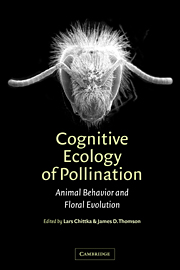Book contents
- Frontmatter
- Contents
- List of contributors
- Preface
- 1 The effect of variation among floral traits on the flower constancy of pollinators
- 2 Behavioral and neural mechanisms of learning and memory as determinants of flower constancy
- 3 Subjective evaluation and choice behavior by nectar-and pollen-collecting bees
- 4 Honeybee vision and floral displays:from detection to close-up recognition
- 5 Floral scent, olfaction, and scent-driven foraging behavior
- 6 Adaptation, constraint, and chance in the evolution of flower color and pollinator color vision
- 7 Foraging and spatial learning in hummingbirds
- 8 Bats as pollinators: foraging energetics and floral adaptations
- 9 Vision and learning in some neglected pollinators: beetles, flies, moths, and butterflies
- 10 Pollinator individuality: when does it matter?
- 11 Effects of predation risk on pollinators and plants
- 12 Pollinator preference, frequency dependence, and floral evolution
- 13 Pollinator-mediated assortative mating: causes and consequences
- 14 Behavioural responses of pollinators to variation in floral display size and their influences on the evolution of floral traits
- 15 The effects of floral design and display on pollinator economics and pollen dispersal
- 16 Pollinator behavior and plant speciation: looking beyond the “ethological isolation” paradigm
- Index
11 - Effects of predation risk on pollinators and plants
Published online by Cambridge University Press: 13 August 2009
- Frontmatter
- Contents
- List of contributors
- Preface
- 1 The effect of variation among floral traits on the flower constancy of pollinators
- 2 Behavioral and neural mechanisms of learning and memory as determinants of flower constancy
- 3 Subjective evaluation and choice behavior by nectar-and pollen-collecting bees
- 4 Honeybee vision and floral displays:from detection to close-up recognition
- 5 Floral scent, olfaction, and scent-driven foraging behavior
- 6 Adaptation, constraint, and chance in the evolution of flower color and pollinator color vision
- 7 Foraging and spatial learning in hummingbirds
- 8 Bats as pollinators: foraging energetics and floral adaptations
- 9 Vision and learning in some neglected pollinators: beetles, flies, moths, and butterflies
- 10 Pollinator individuality: when does it matter?
- 11 Effects of predation risk on pollinators and plants
- 12 Pollinator preference, frequency dependence, and floral evolution
- 13 Pollinator-mediated assortative mating: causes and consequences
- 14 Behavioural responses of pollinators to variation in floral display size and their influences on the evolution of floral traits
- 15 The effects of floral design and display on pollinator economics and pollen dispersal
- 16 Pollinator behavior and plant speciation: looking beyond the “ethological isolation” paradigm
- Index
Summary
Almost all pollination studies neglect the possible effects of predation on flower visitors. Various authors have even claimed that predation is too infrequent to influence pollinator behavior. It is tempting to dismiss the role of predation because it is rarely observed. In the past two decades, however, ecologists have learned to appreciate the central role that predation risk plays in animal behavior and ecology, mostly through a variety of measures animals take to minimize predation. Studies on a wide variety of animals from zooplankton to mammals have suggested that predation risk affects: diurnal patterns of activity; choice of diet, habitat, food patches, and food type; ways of handling food items; social organization; choice of nest sites; and various physiological factors such as diurnal and seasonal levels of fat reserves and respiration patterns (Price et al. 1980; Lawton 1986; Bernays & Graham 1988; Lima & Dill 1990; Clark 1993; Martin 1995; Lima 1998a, b; Ydenberg 1998).
Are flower-visiting animals really immune to predation, or does the prevailing view about the unimportance of predation in pollination systems merely reflect researchers' inattention? In this chapter, I shall review some of the literature and argue that pollination ecologists have mostly overlooked a central factor influencing pollinator traits and pollination systems. Specifically, I ask: (1) Are there significant levels of predation on pollinators? (2) How might predation affect pollinator traits? And, (3) how might predation influence pollinator–plant interactions?
- Type
- Chapter
- Information
- Cognitive Ecology of PollinationAnimal Behaviour and Floral Evolution, pp. 214 - 236Publisher: Cambridge University PressPrint publication year: 2001
- 22
- Cited by



